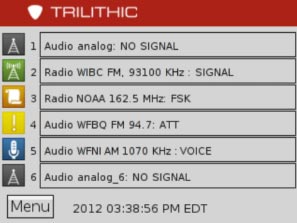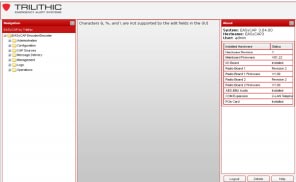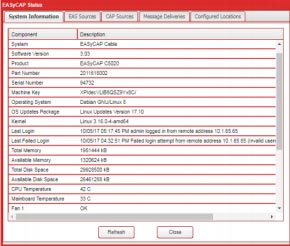Living Happily with a Trilithic EASyCAP

[September 2018] Dana Puopolo got his wife an LPFM license. Even LPFM’s must have an EAS box, so Dana set out to find the best fit for use at WZML. He ended up with an EASyCAP.
Every radio station today must comply with the EAS – just as satellite radio, as well as over the air, cable, and satellite TV all require EAS participation.
Today, however, few companies make these units because of the unique requirements that EAS units fill.
Over the years, I have worked with most of the EAS units out there. While most radio stations traditionally use the either the Sage Endec or the Digital Alert DASDEC, I was surprised to find out that most TV facilities (including satellite and cable) use a unit made by Viavi Solutions: the Trilithic EASyCAP. Even though it originally had cost over twice that of the other two units, this was their favorite.

I had to find out why – especially after Viavi began selling a model customized for radio EAS use at a price very competitive to the other makers – including a balanced stereo audio switcher and three radio receivers inside the unit.
As a result, for almost a year I have been using a Trilithic EASyCAP on WZML, my wife’s Low Power FM station. Unlike many LPFMs we are sending weekly EAS tests, etc.
Build Quality:
The three main EAS momdels run on different distributions of LINUX. That is where any similarity ends.
Compared to the other two, the EASyCAP is built like the proverbial brick outhouse! This units’ build quality is by far better than the competition. The device is heavy – about twice the weight of the others. It “feels” solid; the cabinet is steel and the fit and finish is exceptional .
Inside, this unit uses an industrial class singleboard computer. In fact, everything inside the box looks a cut above the competition. There is a SATA solid state hard drive. The receivers are 2 on one card that plugs into a slot on the mainboard. The design of the unit (standard industrial control mainboards, expansion cards, etc.) means that any needed repairs and hardware updates should be easy.
There are two slow cooling fans on the front of the unit. Yet, noise has not been a problem even though our unit is only about a foot from a live mike.
Control and Display
The Trilithic uses a four-inch color LCD touch screen display for control, menu display, and navigation.

There is a stylus provided, but the screen is big enough for my fat fingers to navigate through it just fine.
I find the EASyCAP menu system itself more intuitive then the others. In fact, my wife was able to initiate a weekly EAS test having never seen the unit before.
Setup
To make it setup as easy as possible, the Trilithic EASyCAP is programmed through a web interface.
The interface is quite extensive. You access it by putting the units’ IP address into the web browser of any computer on the same network.

I gave the WZML unit a static IP, though it will also do dynamic IP (and you can always get the current IP address from the front panel display).
Radio Receivers
Here is another place where the Trilithic shines.
Each of the three radios can be set for AM, FM. or weather band. They are internally connected to the unit via three F-connectors so you can attach individual antennas. I put a four-way splitter on 25 feet of RG-6 connecting to a 19-inch vertical bazooka antenna (the braid also slides down the coax jacket for 19 inches), stuck it just outside a window, and all three signals (two FM and weather) come in perfectly. These radios are sensitive and they sound good!
As with all the settings on the EASyCAP, these are 100% controlled by the web interface – and their status is available right on the main screen.

Signs, Closures, Etc.
Some stations like to have one of those LED signs to display the current EAS activity.
If you want to run one of those signs to display the alert or external closures, the Trilithic can handle them all – especially since the radio model is essentially the TV model with the inbuilt video accessories removed.
Support
Due to the FCC and the FEMA’s requirements, EAS software has a limited universe, so software development is relatively quite expensive.
While manufacturers try to provide upgrades and support, they are at the mercy of when the FCC or the FEMA make major changes to EAS parameters or to security firmware, for example. At that point, the costs may need to be passed on. Eventually, every EAS box will require such an update – the trick is for the manufacturers to keep the costs as modest as possible.
Viavi’s firmware update and customer service policy works as follows:
- You start with a one-year warranty.
- Then, if you need service and/or a firmware upgrade, it will cost $250, and it will cover you for a year.
Thus, this is both an industry standard solution and quite reasonable. Plus, for that cost you get Adam as your personal Trilithic “hand holder,” and he aims to please – so the service is exceptional.
It’s Mine!
We have been using the Trilithic EASyCAP model at WZML-LP for almost a year – and Viavi, you cannot have it back (yes we are paying for it)!
I now understand why TV, cable, and satellite stations have been using them – they just sit and run and run. It has been bulletproof – literally install it and forget it. About all I have to do is check and print out the EAS logs once a month.
My unit at WZML is running completely automatically, and it does just sit and runs and runs and runs. In fact, the only non-routine thing I have had to do with it is update the firmware – which was a snap.
At the original price of $7k, these were a good value considering their build quality, radios, and interface. At around $2500, I consider the Trilithic EASyCAP radio model a steal! It costs about the same as the others but I feel it is a far better built unit. Other engineers with whom I have spoken who have these units also offer the high praise that they deserve.
Highly recommended.
– – –
Dana Puopolo is the Chief Engineer at Rowan University’s WGLS in Glassboro, NJ. You can reach Dana at dpuopolo@usa.net
– – –
